Changelog
Follow up on the latest improvements and updates.
RSS
In an effort to provide users with an even more intuitive and streamlined experience, we are excited to unveil the
newly redesigned Homescreen
of AWR. This major update brings forth a fresh and modern interface along with a host of new functionalities and improvements.The new Homescreen serves as an insightful, central dashboard of the application, allowing users to see in a glance
key ranking information
for all the websites they are monitoring with AWR.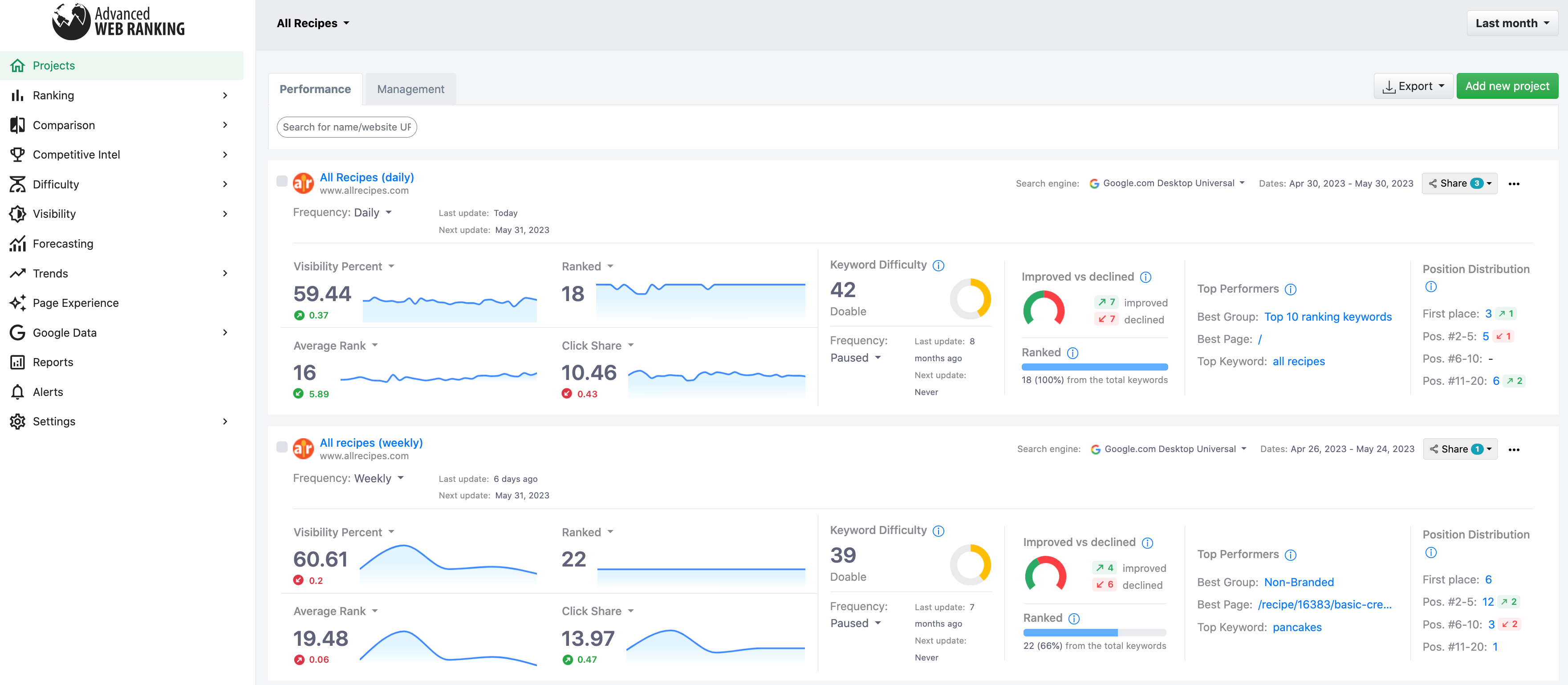
With the redesigned
Performance view
, users can effortlessly monitor their website's performance, gaining valuable insights into their SEO progress and achievements. Additionally, the Management view
provides a wealth of project status updates and essential setup information, making it easier than ever to stay organized and in control.Performance view
As we aimed to deliver an enhanced performance analysis experience to users, a range of new features and improvements have been incorporated into the redesigned Performance view as outlined below:
[New]
Ranking performance displayed for a specific search engine
The progress in terms of rankings can now be checked for specific search markets, in addition to "all" search engines. The default search engine selection now displays the metrics computed for the first search engine of the project. When a user manually selects a specific market, their preference will be saved for future sessions, and the metrics computed for the manually selected search engine will be shown.

[New]
Top ranking keyword
When a single search engine is selected, the
Top Keyword
metric will be shown as part of the Top Performers KPI. This metric represents the term with the highest Estimated Visits recorded for the main website within the selected time interval.For "all" search engines, same as before, the
Best Market
will still be displayed as one of the Top Performers. The Best Market represents the search engine with the highest Visibility Percent recorded for the main website within the selected time interval.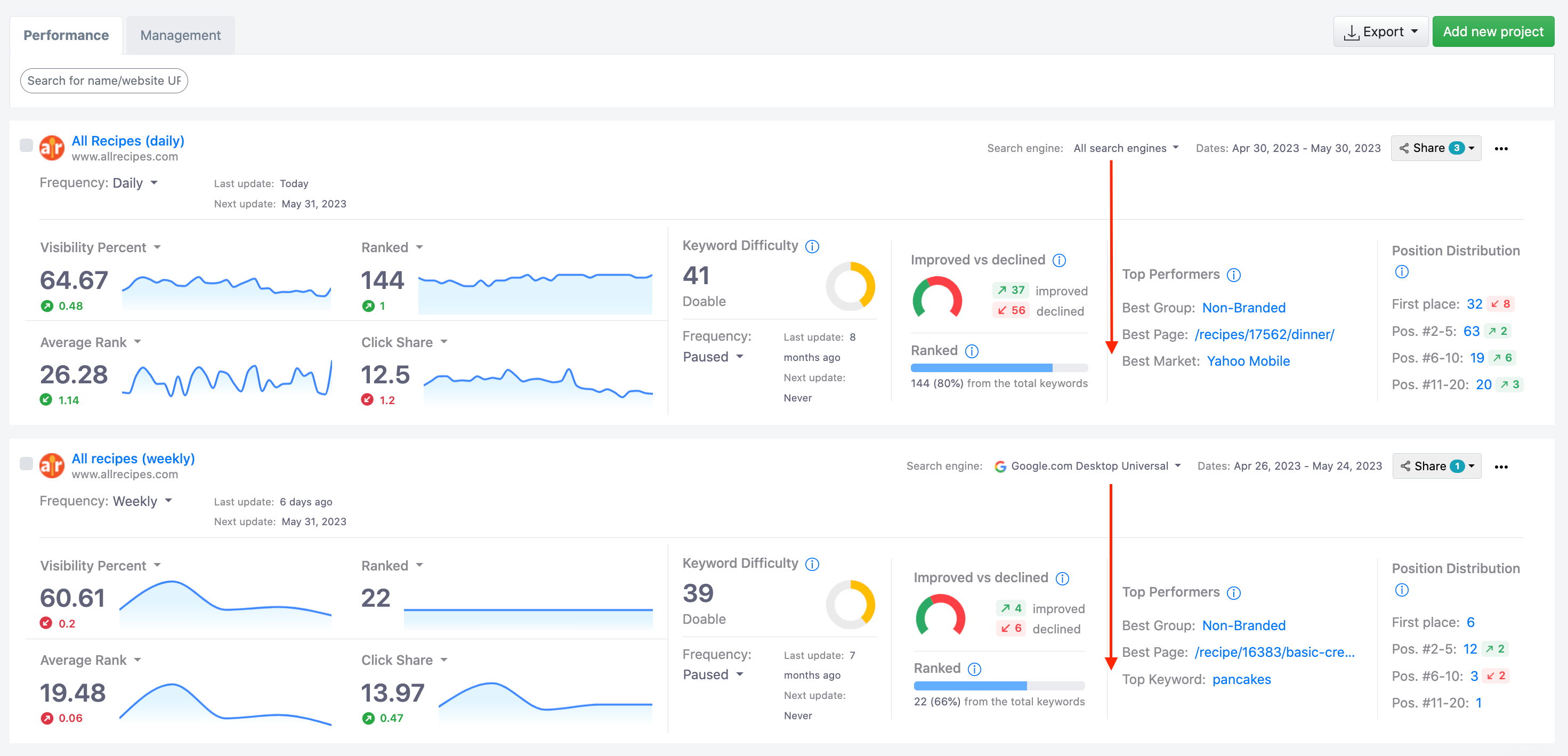
[New]
First place metric added to the Ranking Distribution KPI
The Ranking Distribution KPI, which displays the distribution and changes in top ranking positions, has been enhanced with the addition of the
First place
metric. This metric shows the total number of keywords ranking on position 1
across the selected search engine(s) for the latest update date within the chosen time frame. The changes are calculated by comparing the values recorded on the start and end update dates within the applied time frame.
[New]
Two new performance KPIs
Following the update two new performance KPIs were introduced:
Keyword Difficulty
and Improved vs. declined
.The
Keyword Difficulty KPI
provides insights into the Global Difficulty score of the main tracked website. It takes into account the Domain Difficulty, URL Difficulty, and Content Score of the top 10 ranking results across the selected search engine(s).The
Improved vs. Declined KPI
displays the number of keywords that have experienced an increase or decrease in their position on the selected search engine(s), comparing the start and end update dates within the selected time frame.Additionally, within the Improved vs. Declined KPI, the
Ranked
metric was also introduced. This metric shows the number and percentage of keywords that the main tracked website is ranking for on the selected search engine(s) out of the total number of terms added to the project. This value is calculated for the latest update completed within the applied time frame.
[New]
Default Display: Performance stats for Last month
The default mode for visualizing the ranking data has been updated to display the
Last month
's stats instead of the Last 2 updates
. Furthermore, we have introduced a new time frame option - Last year
- giving one the flexibility to choose between visualizing the data for the Last 2 updates, Last month, Last 3 months, or Last year. This enhancement allows for better customization and analysis of the performance metrics.[Improved]
The calculation method of the KPI metrics has been changed
All metrics within the performance KPIs now reflect the current values, the ones recorded during the latest update. The changes in these metrics are calculated by comparing the values recorded at the start and end update dates within the selected date range. The start and end dates are displayed on the top right of each website card.
Previously, these metrics were calculated as a sum or average across all update dates in the selected interval. Now, the Visibility metrics align with the values reported in the Visibility section.
The exception to this is the Top Performers KPI, for which the calculation method remains the same as before. The top metrics of this KPI are calculated based on the estimated visits recorded across all updates within the selected interval.
Management view
After the redesign, the Management view offers a wealth of information in a more user-friendly interface. In addition to displaying the number of tracked keywords, search engines, and selected search depth for each project, one can easily access the following information:
- Tracked countries and devices
- Status of Google Analytics (GA) and Google Search Console (GSC) syncs
- Resources consumption, differentiating between scheduled and manual updates
- List of assigned team-member users
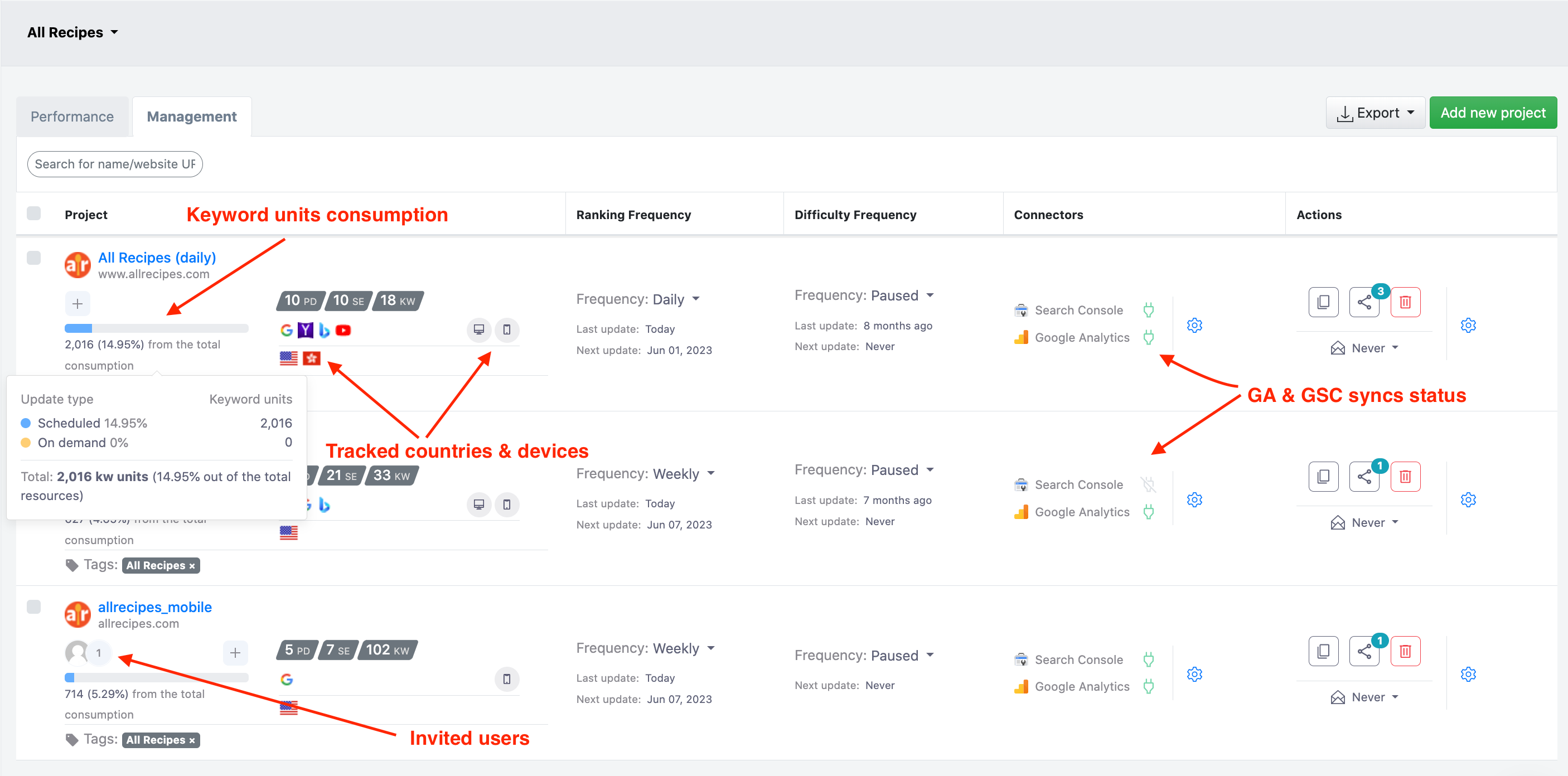
Furthermore, the Management view provides convenient shortcuts to essential features and settings, including:
- Google settings
- Project settings
- User management
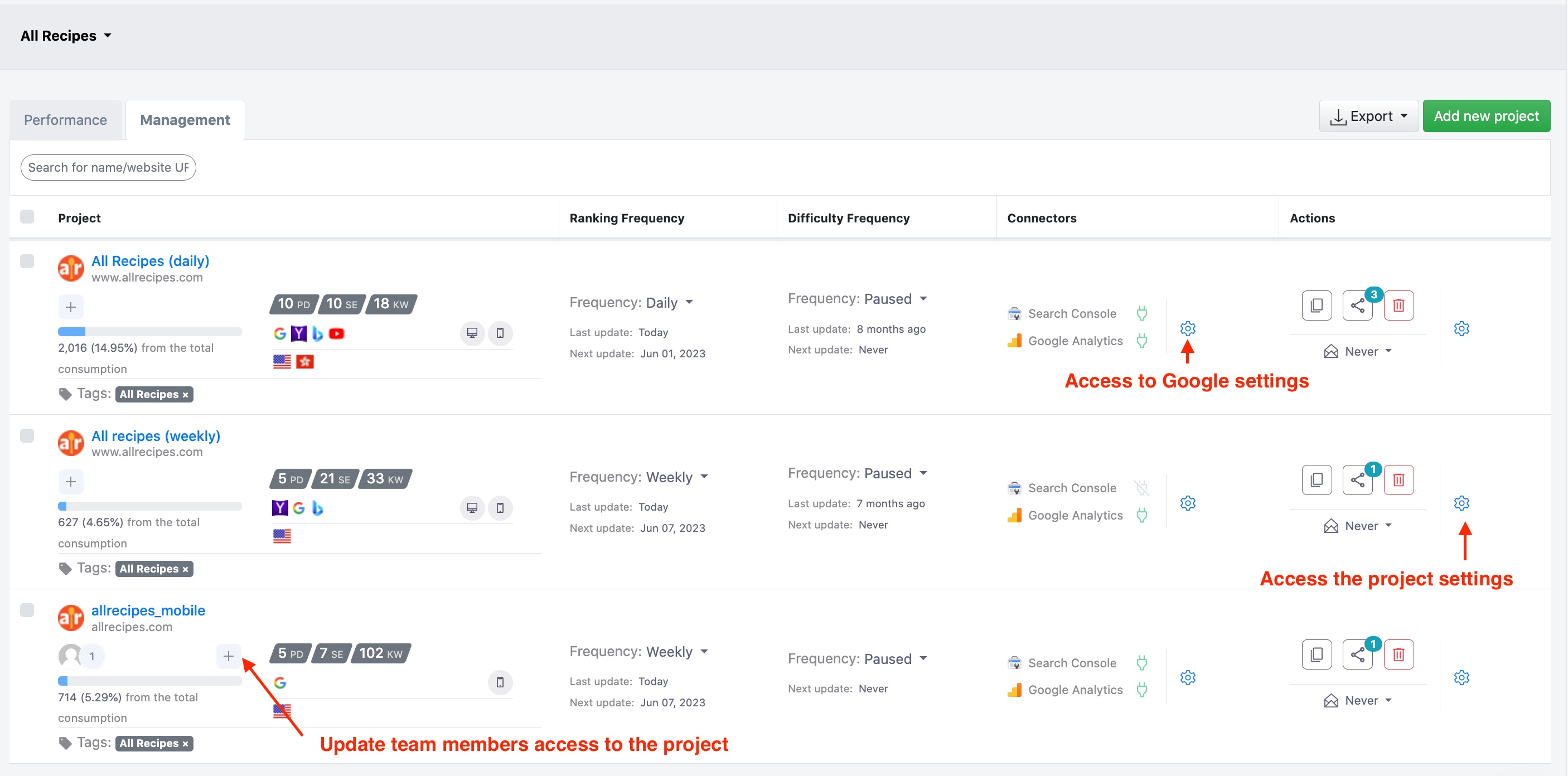
Additionally, one has the ability to perform various actions such as deleting or duplicating a project, adjusting email update frequency, and creating a new shareable link.

With these enhancements, managing AWR projects becomes even more efficient and streamlined.
SERP Features for Bing have been incorporated as an optional column into UI reports, mirroring the functionality already available for Google search engines.
The inclusion of Bing features in AWR's UI reports will mostly benefit users who rely on Bing for their SEO strategies or primarily work with clients targeting Bing's audience as they can now effortlessly see the types of results a website was found ranking for, and compare its performance against competitors on the Bing platform.
To access this feature, you can choose to display
SERP Features
as an optional column in the ranking table within three key reporting sections: Ranking > Keywords, Ranking > My Sites, and Comparison > Websites. 
Additionally, in the Ranking > Keywords section, users can now easily track the number of Bing features achieved and uncover potential opportunities for improvement. The
SERP Features KPI tab
provides insights into the number of Organic and SERP features listings associated (achievements
) with the selected website, as well as the total count of search results displayed (opportunities
) by Bing in the SERPs retrieved for the targeted keyword set.
Users can also access information about the
distribution of SERP features by their type
, including the number of positions achieved out of the total opportunities
. This allows for a comprehensive understanding of the Bing SERP landscape and the performance of the selected for various feature types.
Similar to other key performance indicators (KPIs),
the achievements, opportunities, and spread of SERP features are calculated based on the report's inputs, including keywords, website, and search engine selection
. These values are also influenced by any advanced filters that have been applied
. It's important to note that these metrics are updated in real-time, reflecting the data based on the inputs and applied filter(s).
We are excited to announce a significant update to the API functionality that is meant to enhance even more our users' SEO analysis and research capabilities. Following the update, new operations have been introduced offering now the ability to easily
export the keyword difficulty data
orestimate
and run a difficulty update
via API.💡
The difficulty metrics -
Global Difficulty, Domain Difficulty, URL Difficulty, and Content Score - are computed only after an on-demand or scheduled difficulty update has been completed for a project/set of keywords. Each difficulty update uses regular units from the
plan resources as follows:
1 keyword updated for difficulty, on 1 search engine = 2 keyword units
Export the keyword difficulty data
The keyword difficulty metrics can be retrieved from AWR either as a .CSV file or as a plain text response with the export keyword difficulty API call. In addition to the difficulty metrics, the output will also include the Search Intent, SERP Features, and Search Volume data.
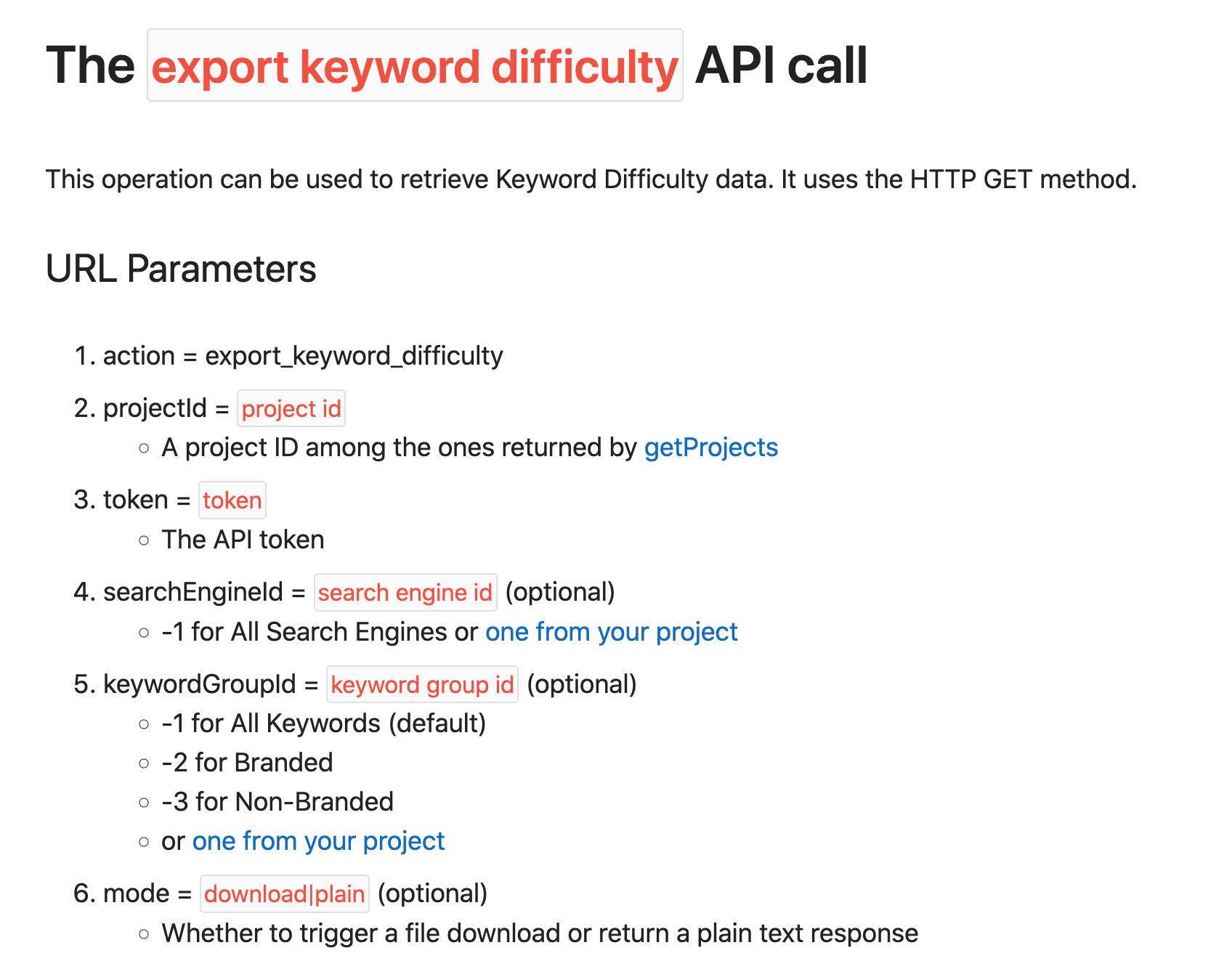
Example request
https://api.awrcloud.com/v2/get.php?action=export_keyword_difficulty&projectId=1&token=myAPItoken&keywordGroupIds=1
Estimate the units consumption for a difficulty update
The estimate keyword difficulty update API operation indicates the number of units necessary for a keyword difficulty update. The call can be requested for one or multiple projects and the output is returned in JSON format.
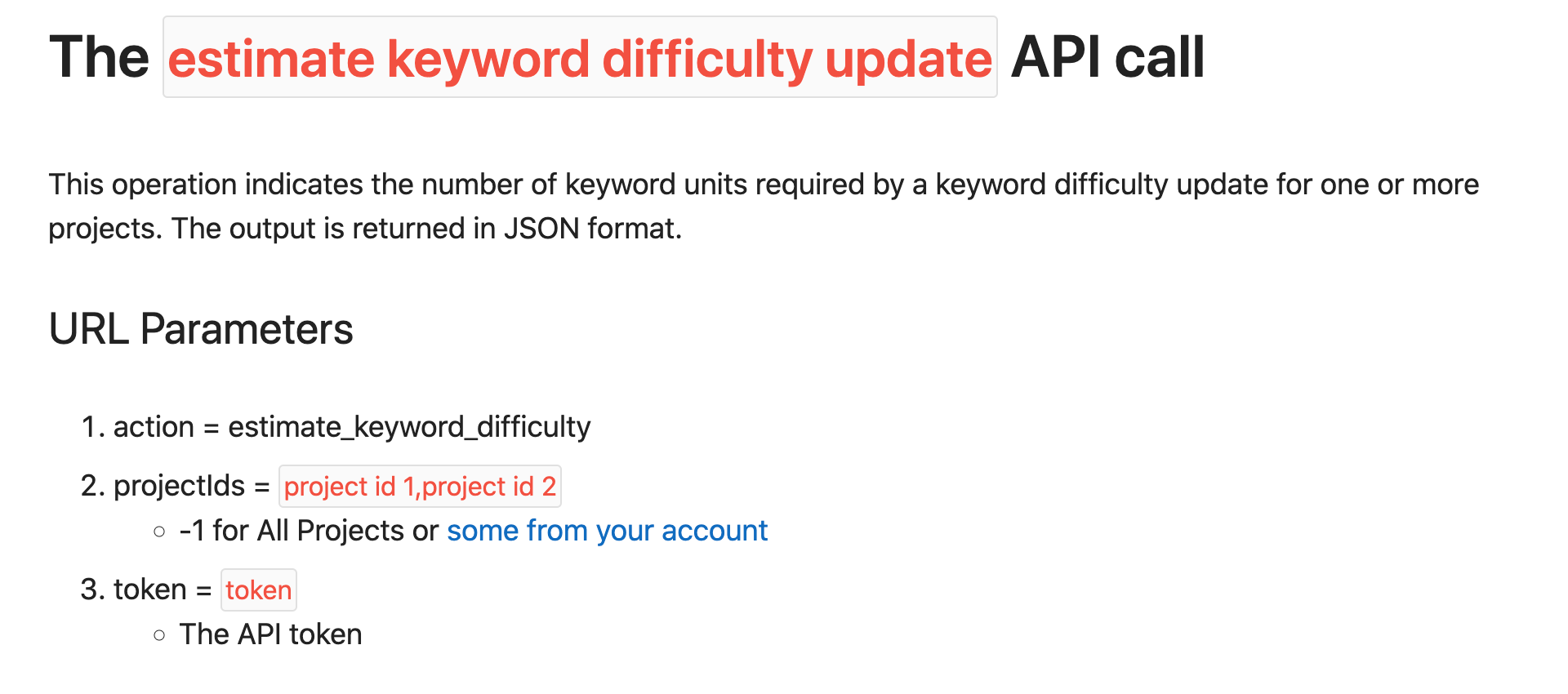
Example request
https://api.awrcloud.com/v2/get.php?action=estimate_keyword_difficulty&token=myAPItoken&projectIds=4,6
Request a keyword difficulty update
To start a keyword difficulty update for one or multiple projects one can use the request keyword difficulty update API call.
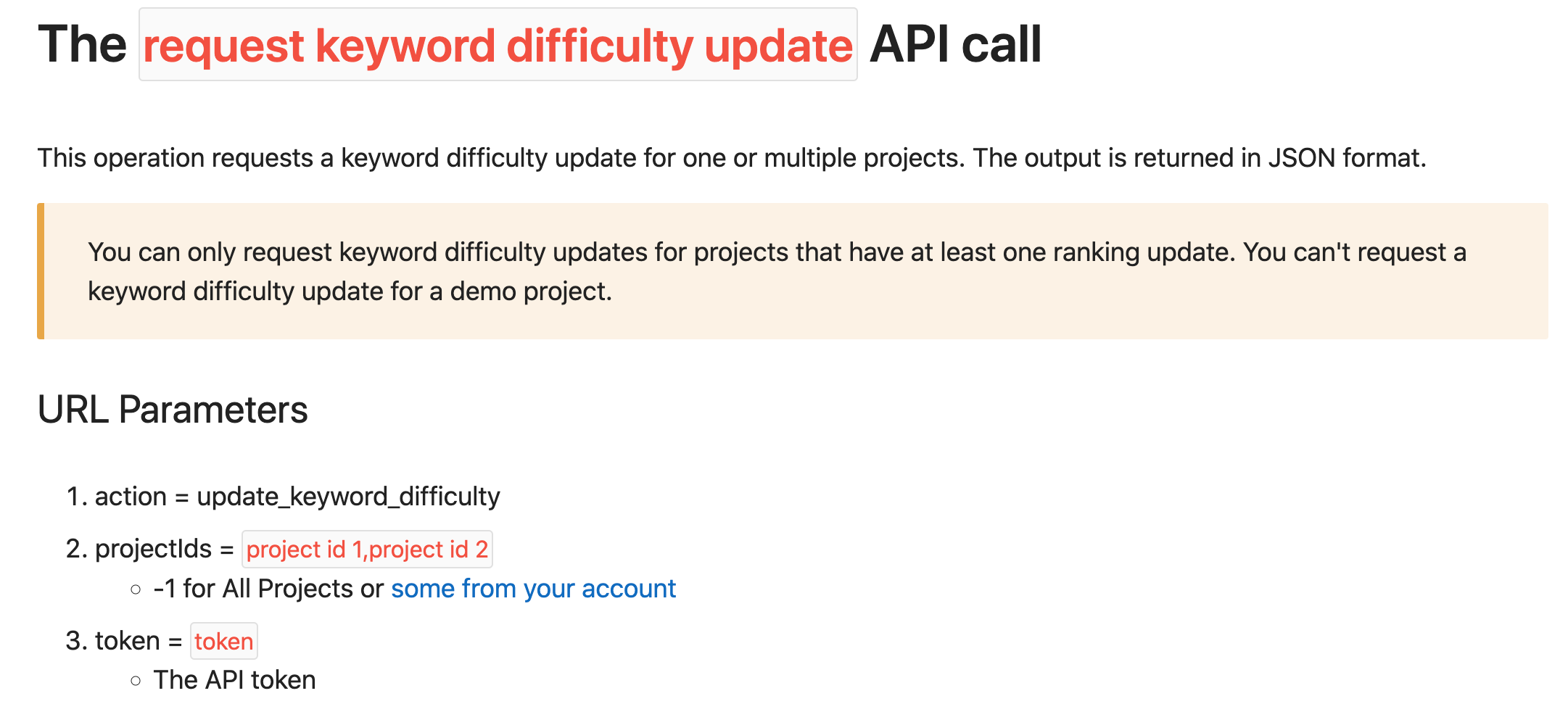
💡
Updating the difficulty metrics requires data from the top 10 search results. This means that the update cannot be initiated unless the ranking data has already been collected from the search engines and processed.
Please note that starting a difficulty update does not automatically refresh the ranking data. The difficulty metrics are processed solely based on the latest ranking dataset available.
Example request
https://api.awrcloud.com/v2/get.php?action=update_keyword_difficulty&token=myAPItoken&projectIds=4,6
Feature availability
The developer API feature is available for all types of yearly subscriptions and, monthly, starting with Agency and higher.
Google's
Deals
SERP feature - which enables searchers to quickly find the best deals and offers for products or services they are looking for - is now available for monitoring with AWR. This comes as a great addition for marketers who want to keep track of the performance of their promotion pages on Google search.When users type a query related to products and services on Google's mobile SERPs, they may come across the Deals feature, which displays a selection of relevant offers. Usually, the Deals group occupies a prominent placement among the first organic search results, rendering them easily visible and accessible to users.

The pages featured in the Deals group, as for the other search results, are based on a series of factors, such as the relevance of the query, the quality, and popularity of the offer, user's location or search history.
To track the Deals results in AWR, one needs to use the
Google Mobile Universal
search engine. This version of Google can be added to a project from the Project settings > Search engines section.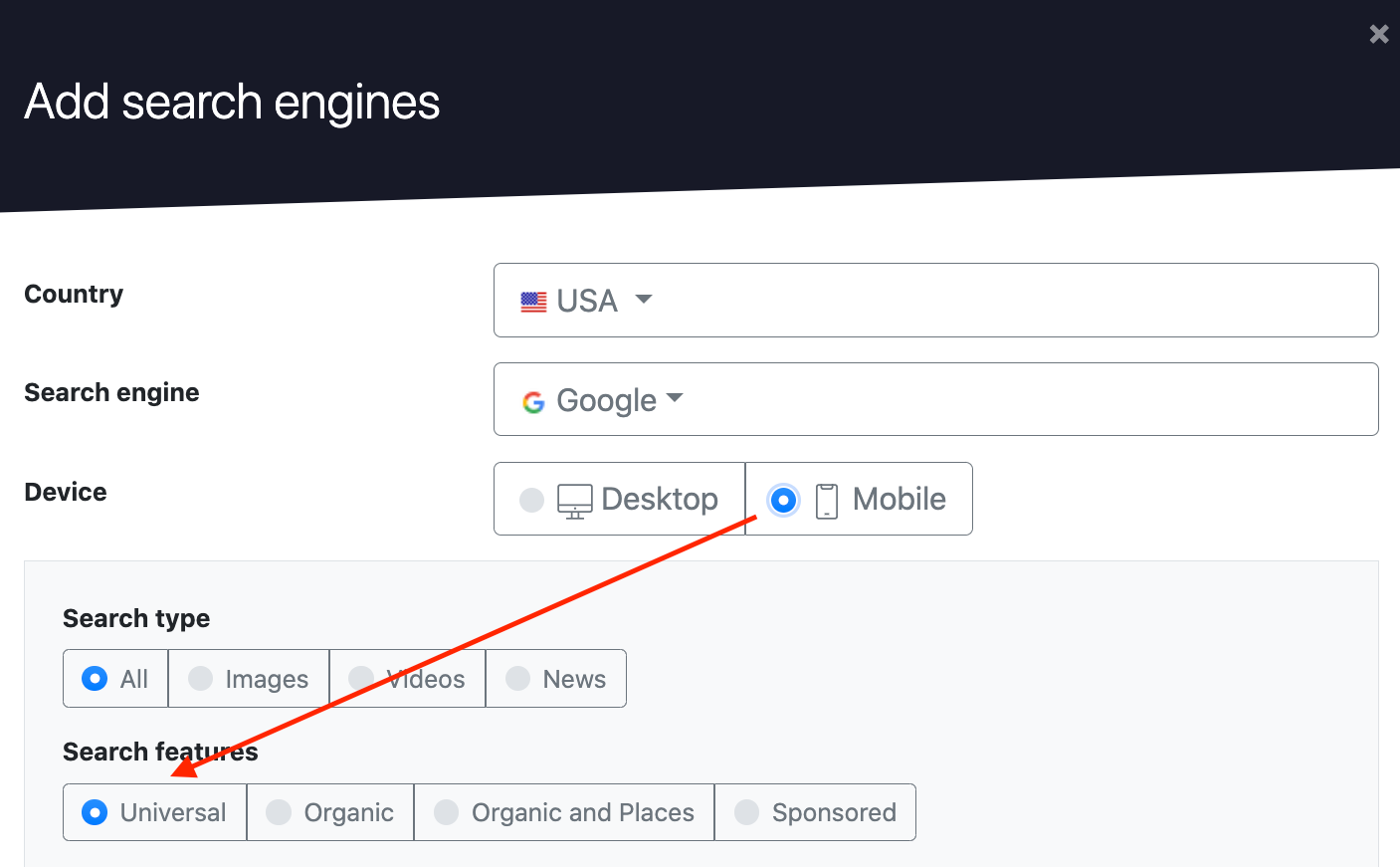
💡
When the Universal version of Google is being monitored, AWR will report the positions of Organic entries and other types of results such as Deals, Local 3-pack, Featured Snippets, PAAs, Apps, Images, Job Postings, etc. as ranked, if they are found in the SERP. Detailed information regarding Google's search preferences and features that can be monitored using AWR can be found
here and
here.While tracking the Google Mobile Universal search engine, the keywords which have generated the Deals feature can be promptly recognized with the aid of the
SERP Features
filter: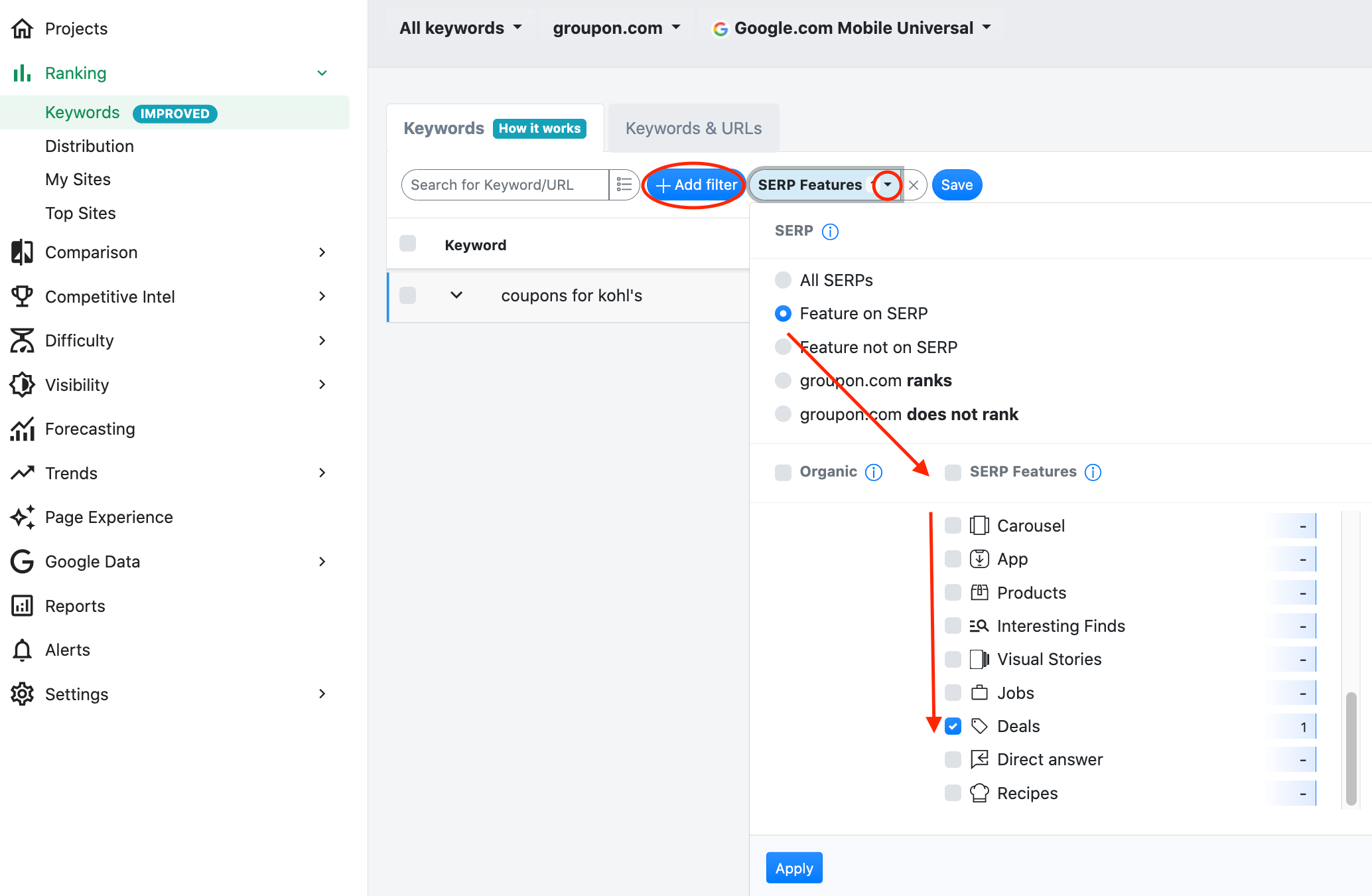
When looking at the filtered results, the
SERP Features column
shows the features that are present in Google's Mobile SERPs for each keyword: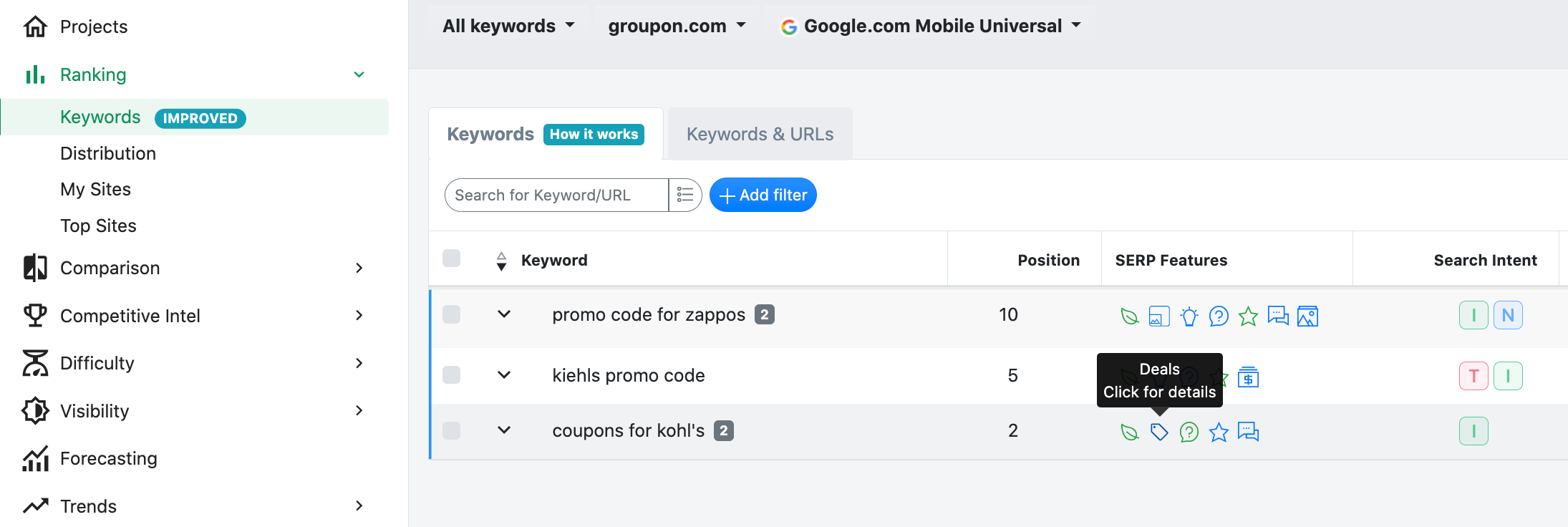
As the promotions featured in the Deals group are part of the same search result element, they will be reported on the same ranking position when found in the SERPs obtained from Google:
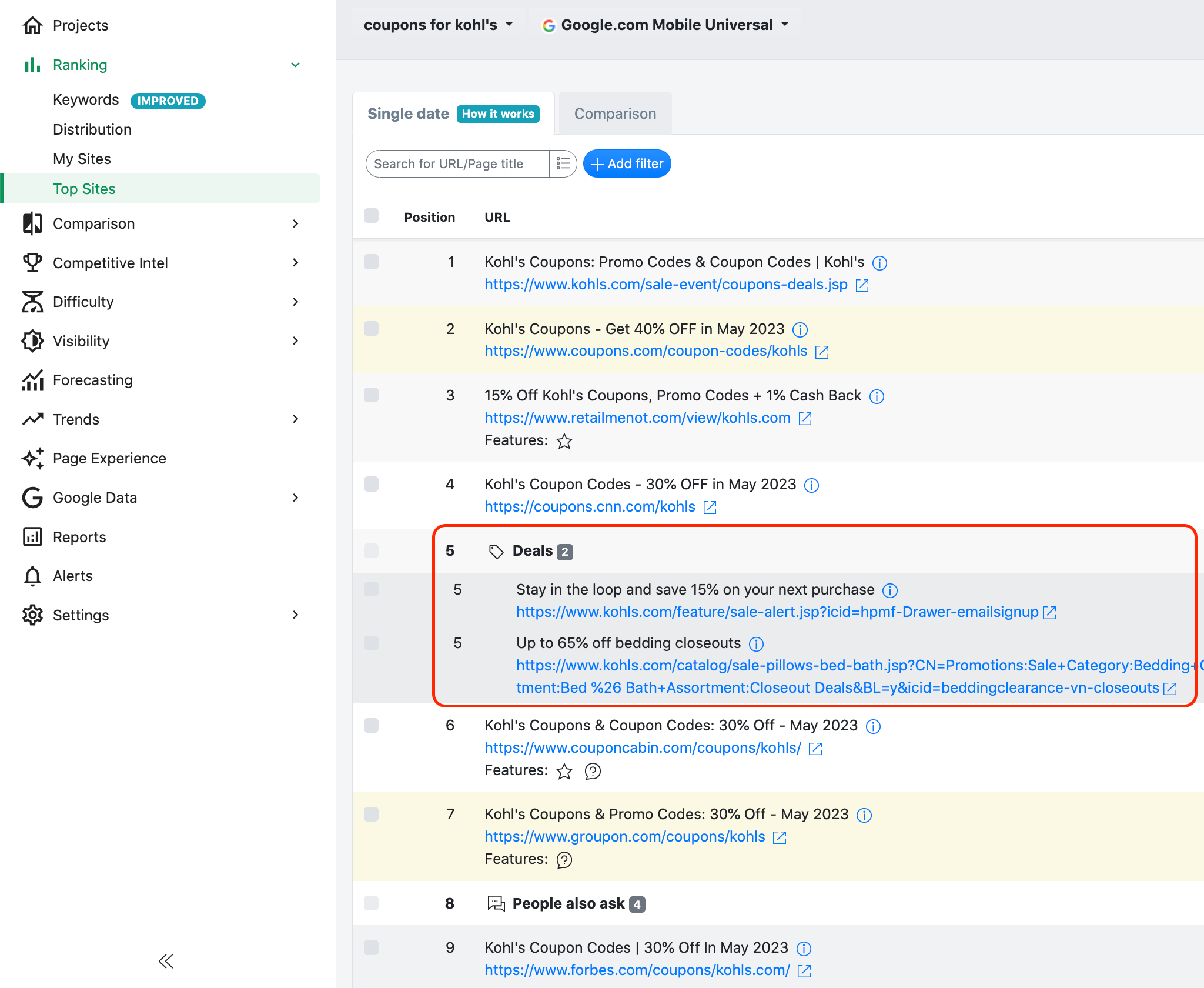
We are excited to announce our latest feature -
sign in with Google
! We understand the hassle of creating and remembering multiple login credentials, which is why we have implemented this feature.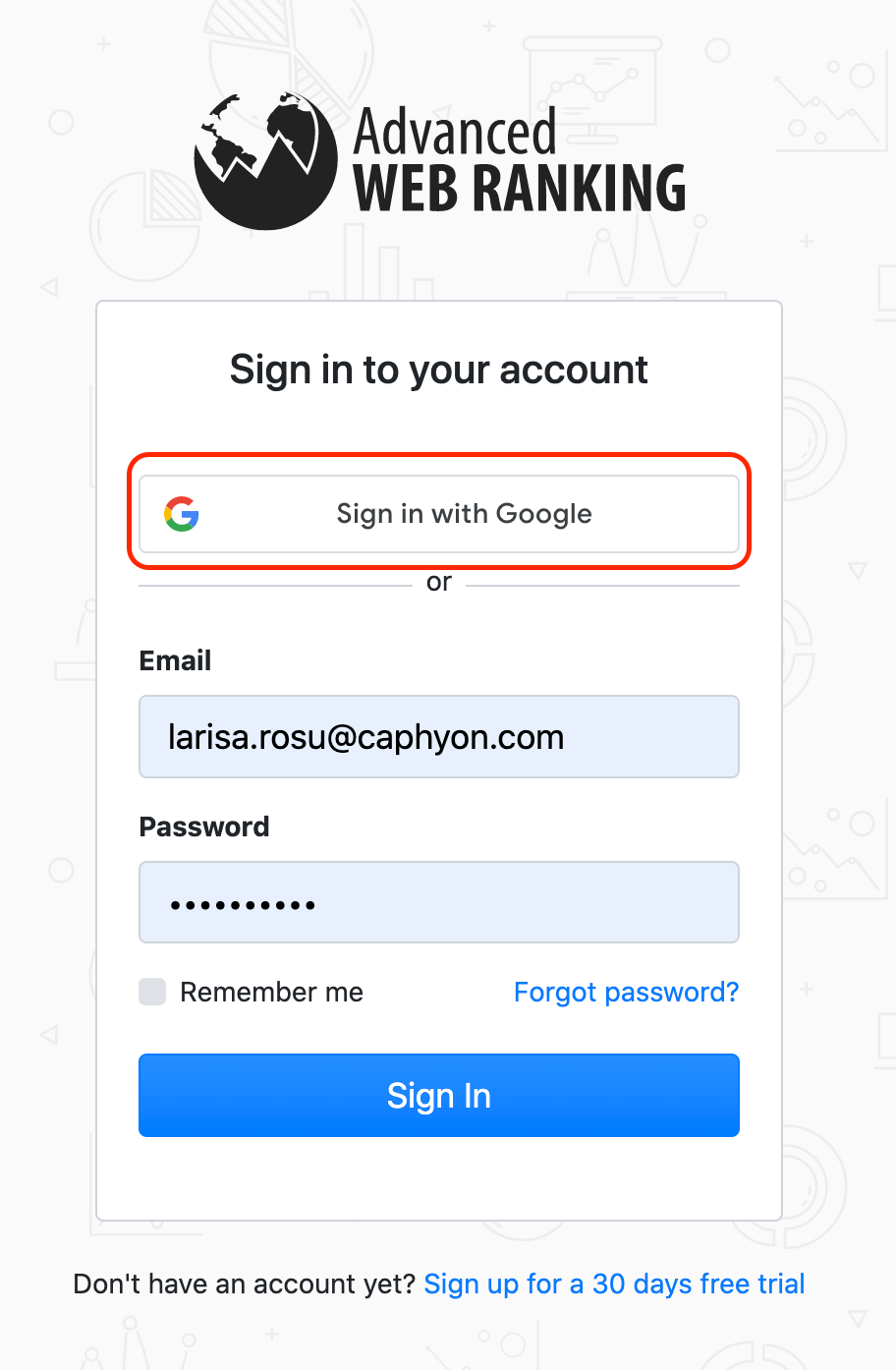
Signing in with Google can save time and reduce the burden of managing passwords. Plus, it offers an added layer of security as during Google's authentication process the user's identity is verified, ensuring that only authorized individuals can access AWR. And for users who have enabled two-factor authentication, the security of the login process is further enhanced.
The sign-in preference can be checked using the Settings > General settings > User settings section.

At AWR, we are dedicated to continuously improving our application and providing our users with the best possible experience. We are confident that this new feature will make the sign in process easier, faster, and more secure than ever before. So why wait? Try it out today and experience the benefits for yourself!
Google's Jobs pack is a feature specially designed to help both job seekers and employers. It provides job seekers with a more convenient way to find job opportunities directly from the SERP (therefore without having to visit multiple job platforms or company websites), and employers to showcase their job openings to a wider audience. By optimizing their postings for the Jobs feature, employers can increase their chances of attracting qualified candidates and filling the job openings quickly.
When someone searches for a specific job-related term, such as "marketing jobs" or "software developer near me", Google may display on its SERPs a pack of job openings deemed relevant to the search query.

Each of the job listings contains essential information such as the job title, company name, location, salary range, or the date the job was posted. A direct link to the company's job board, where job seekers can learn more about the job opening and apply if interested, is also included.
In AWR, the
Jobs pack is being tracked with the Google Universal search engine
: Google Desktop/Mobile Universal for desktop, respectively mobile search results. The Universal version of Google can be added to a project from the Project settings > Search engines section.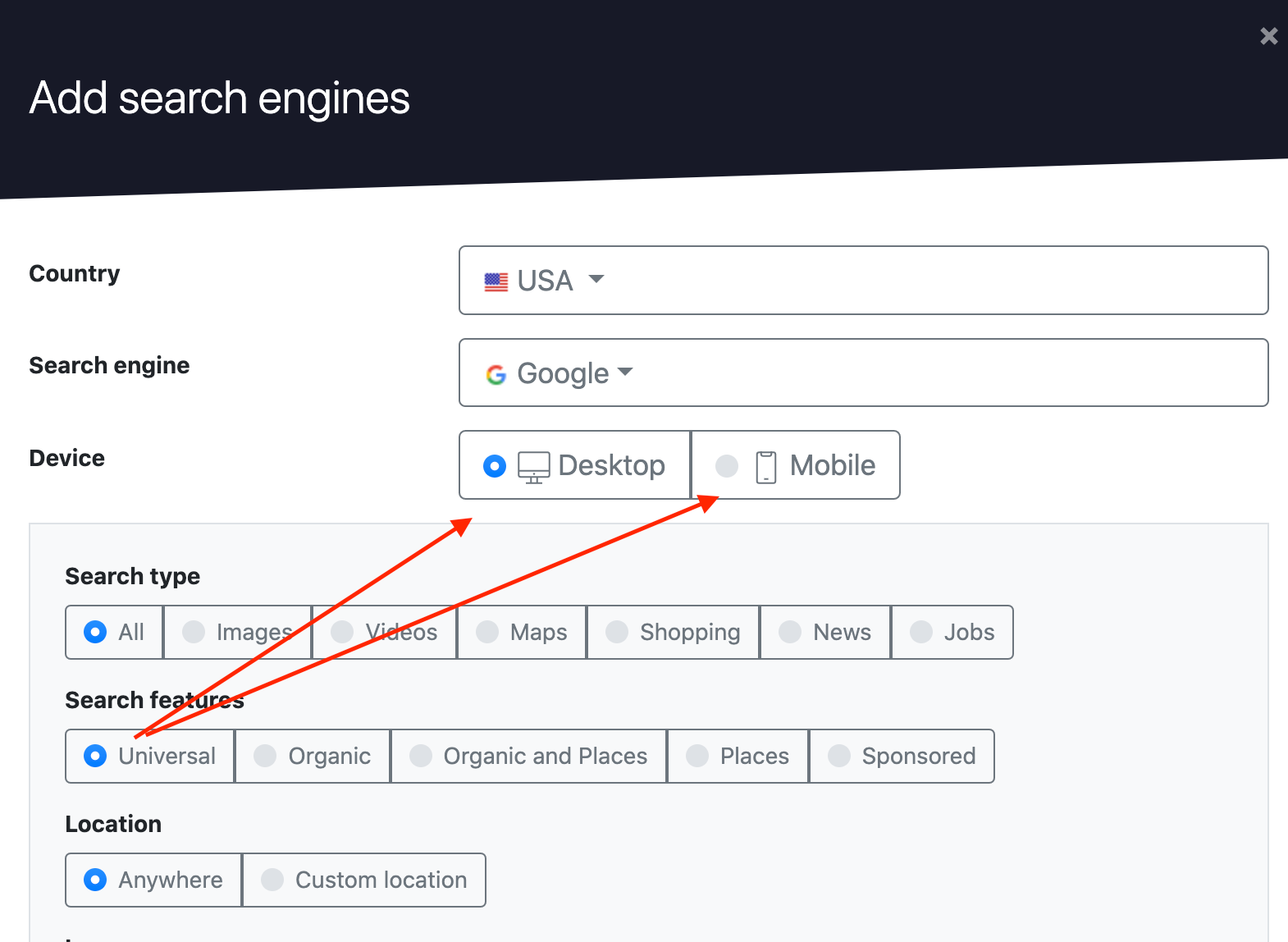
💡
When the Universal version of Google is being monitored, the positions of Organic entries alongside the URLs from Local 3-pack, Featured Snippets, People Also Ask, Images, Videos, Knowledge Panels, Job postings, and other types of results will be reported as ranked if found in SERP. More information about Google's search preferences available in AWR can be found in this article
here.When monitoring a Universal search engine, the keywords which have triggered the Jobs pack can be easily identified with the help of the
SERP Features filter
: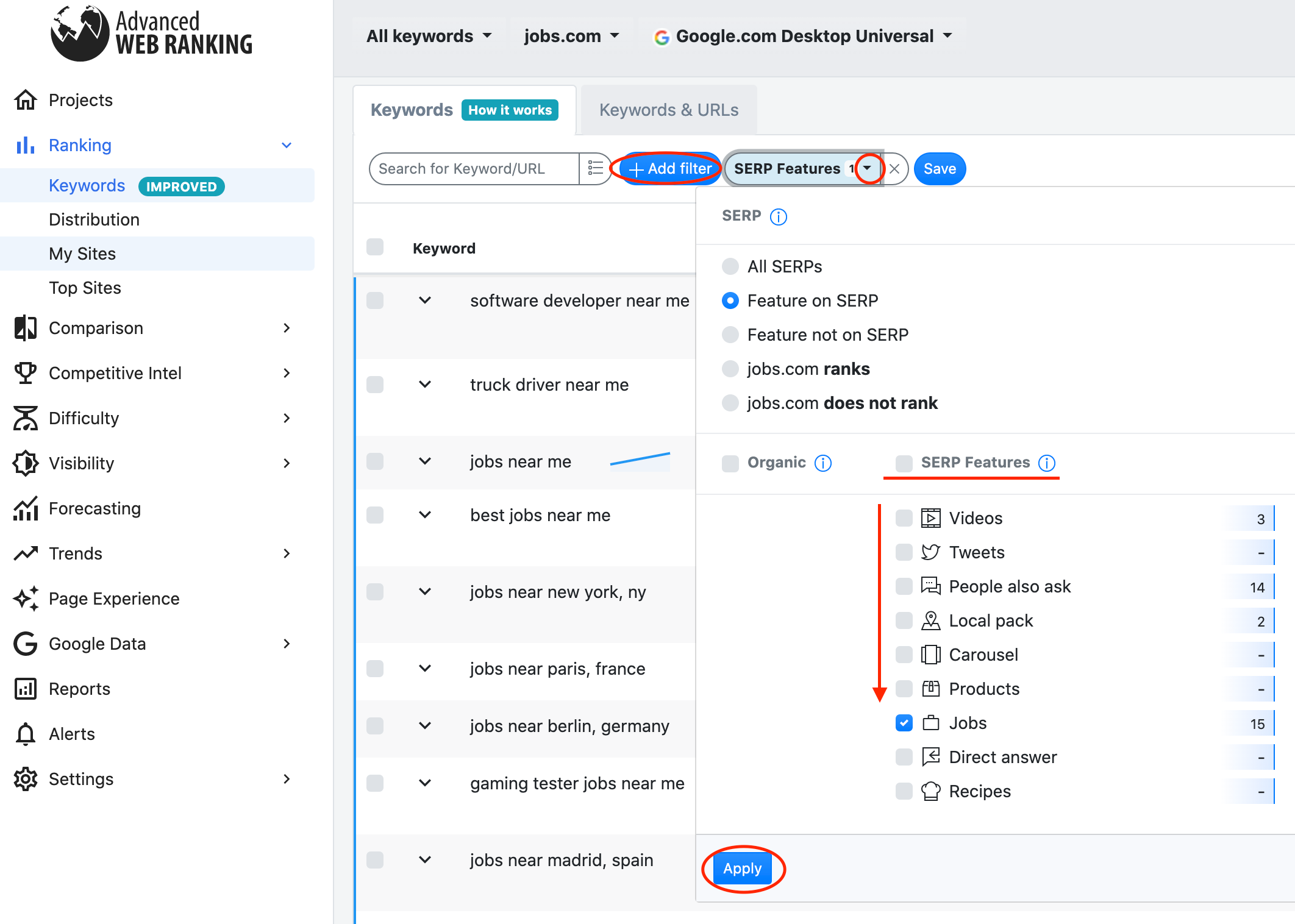
In the filtered results, the
SERP Features column
shows which features are present on Google for each keyword.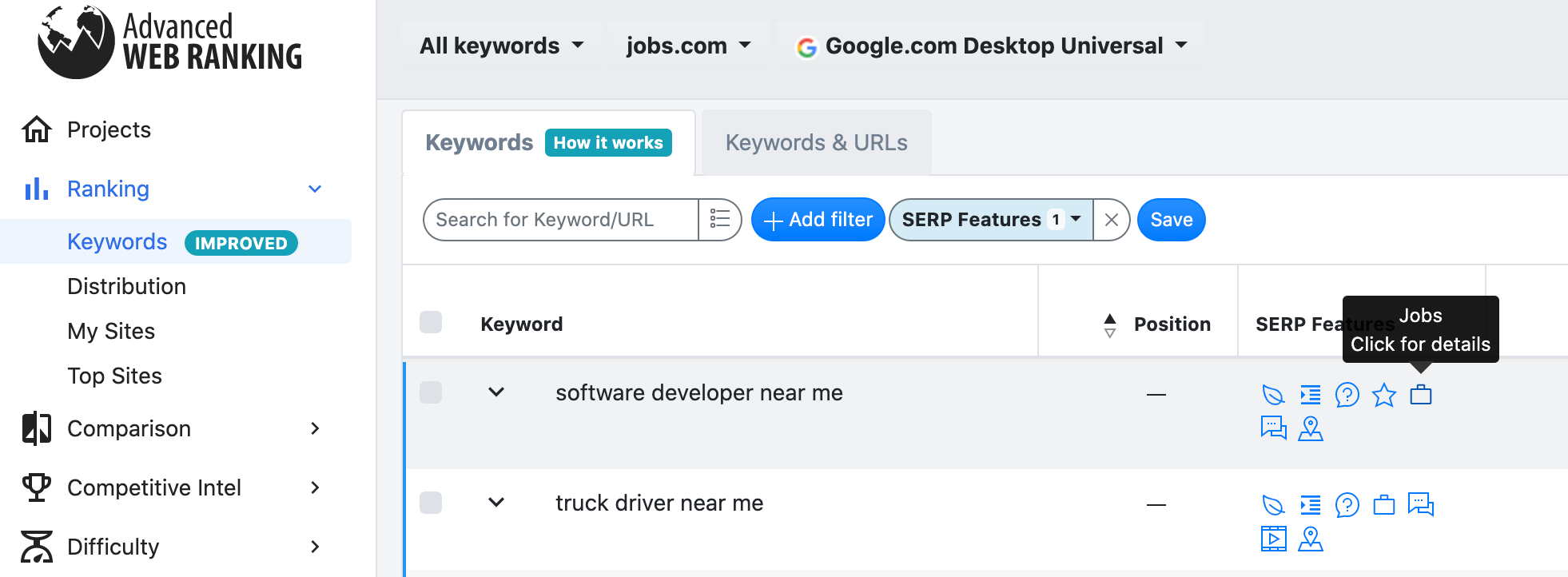
When found in the SERPs retrieved from Google, the job openings featured in a Jobs pack will be reported on the same ranking position, as they are part of the same search result element.
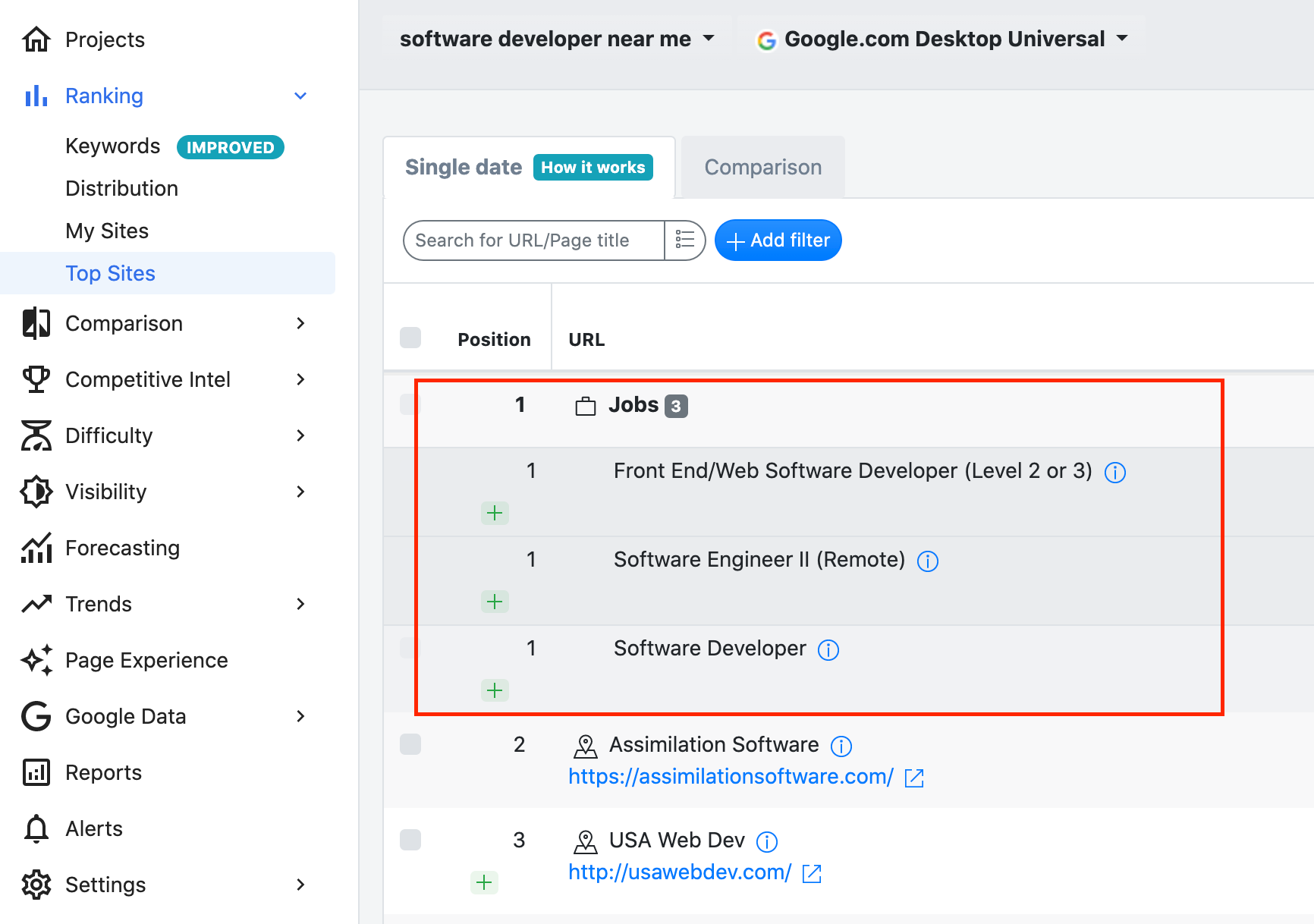
💡
It's important to note that Google's Jobs SERP feature is distinct from Google's Jobs vertical
. As described at the begging of this article, the Jobs SERP feature is a part of the regular Google SERP while the Google Jobs vertical is a separate search engine which aggregates job listings from various sources, including job boards, company websites, and staffing agencies, to provide a more comprehensive job search experience.

AWR allows also tracking job openings from Google's Jobs vertical. This is possible with the dedicated
Google Desktop Jobs search engine
: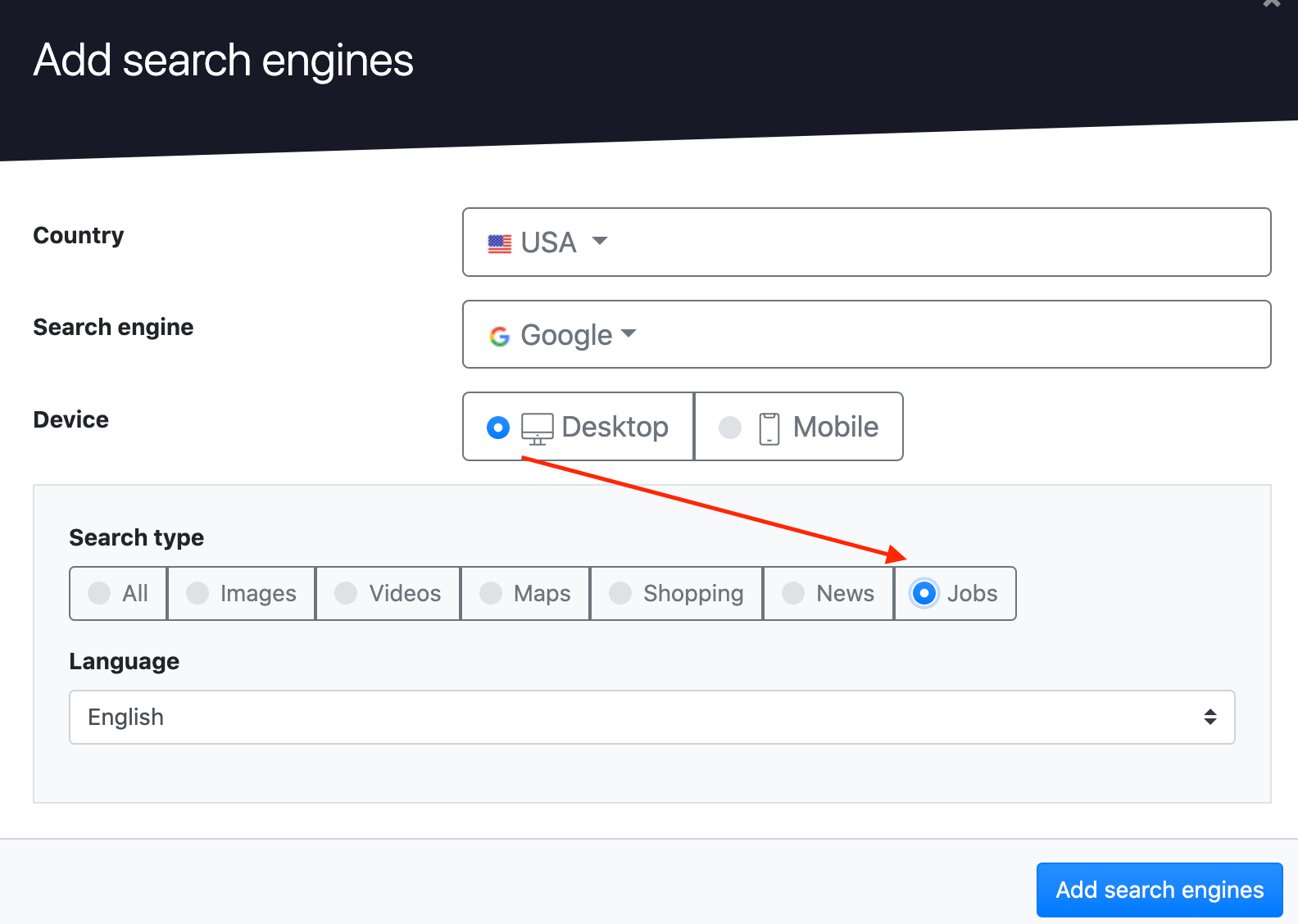
As we aimed for a simplified keyword management, the terms added for monitoring that are directly associated with the project's main website (domain's name or variations of it) are now automatically identified and marked as Branded. Once a keyword is identified as a brand term the "B" label will be displayed near it in all UI reports where the keyword appears.

In addition, the former Branded & Not-Branded keyword groups have been turned into dynamic groups and are now constantly updated based on automatic checks for branded terms (which take place once a month or every time new keywords are added to the project) and any manual user intervention (when the user manually marks the keywords as branded or not branded).

If a keyword is marked as not branded it will no longer be included in the Branded dynamic group on future automatic checks, and vice-versa.
Same as before, a term can be marked as branded or not branded using the
Manage
drop-down menu which is displayed once the keyword is selected using the corresponding checkbox.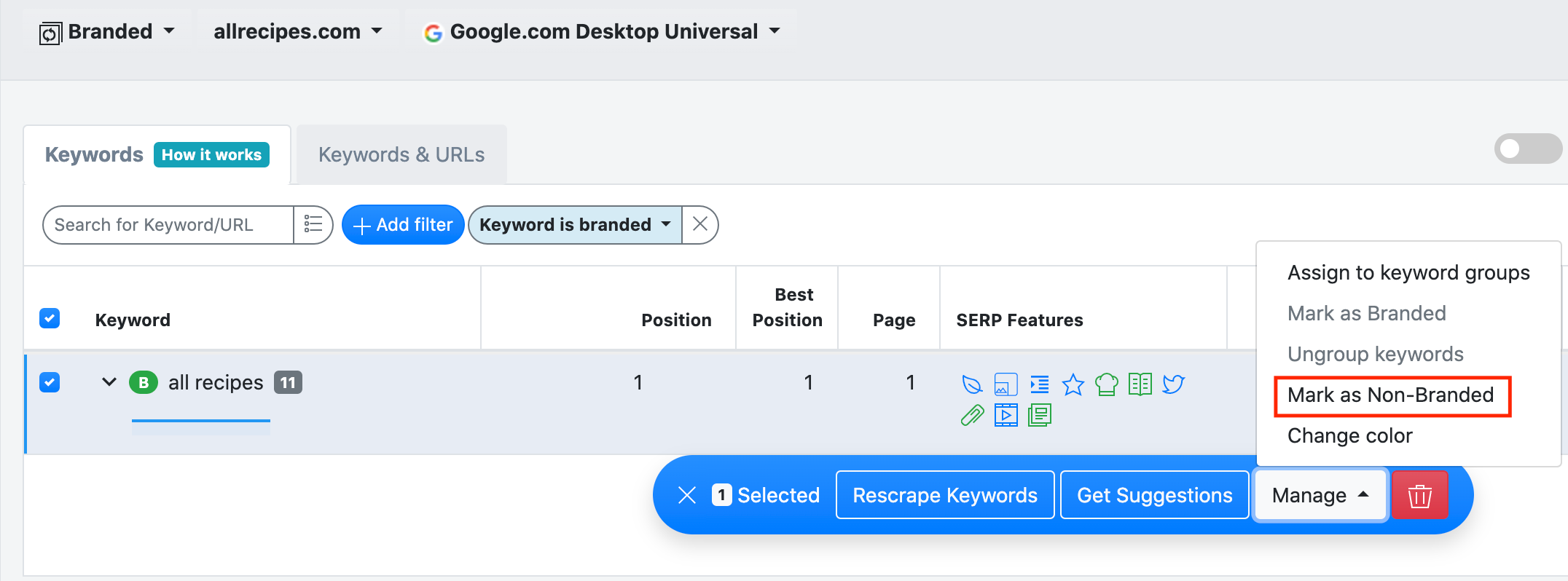
A dynamic group's input keywords can be edited from the Project settings > Keywords section.
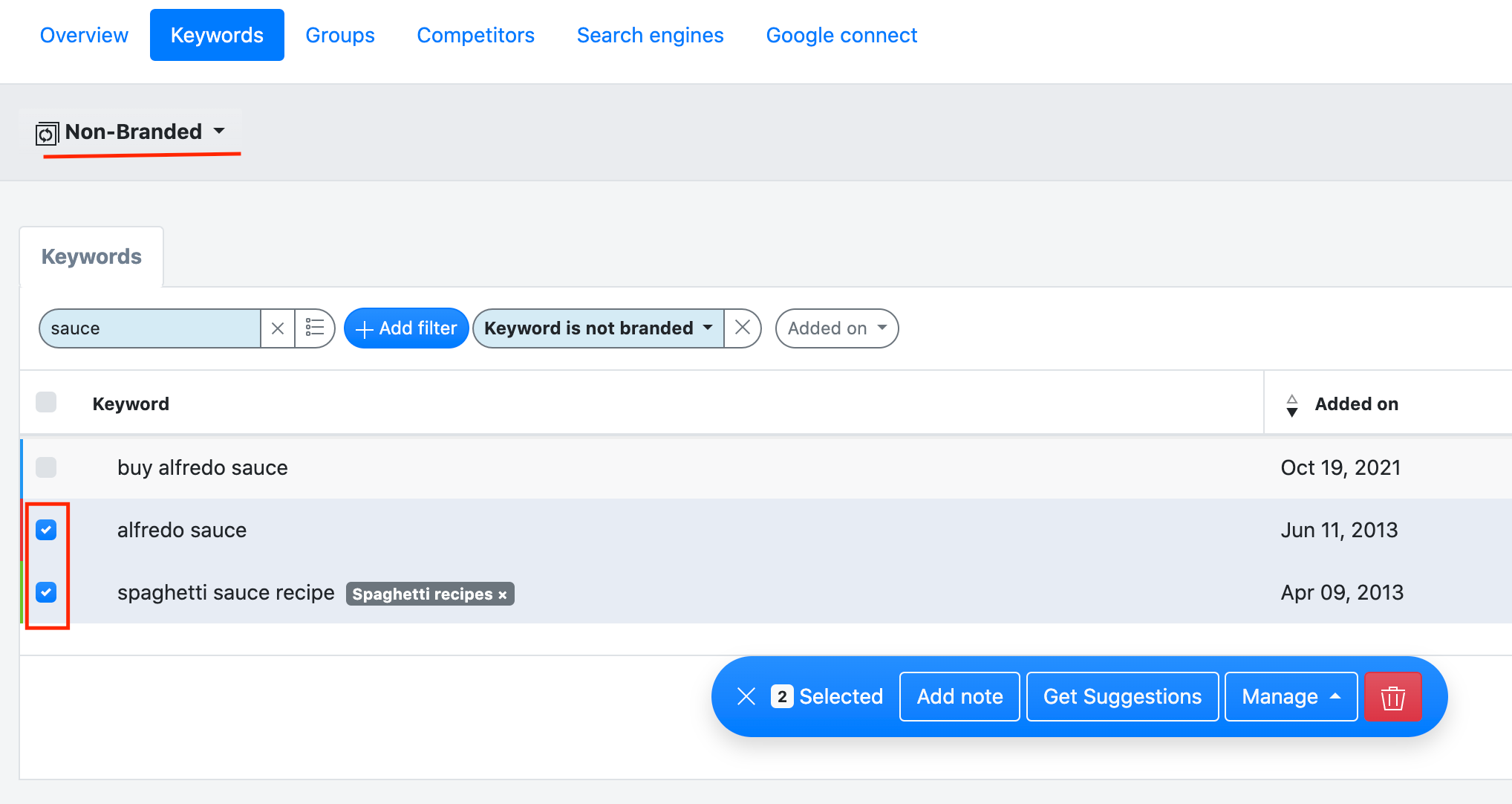
With this update, improvements have been made to the alerting system regarding the detection of SERP Features' occurrence or their sudden change among the search results retrieved from the search engine(s) added for monitoring to AWR.
Now, the
SERP Features
alert with the Website ranks
condition enabled will report the keywords that achieved a new SERP Feature or lost one, from one update to another. When first creating such an alert, the initial trigger will report the list of existing search features of the selected website. Afterward, the alert will be triggered only for new and lost features.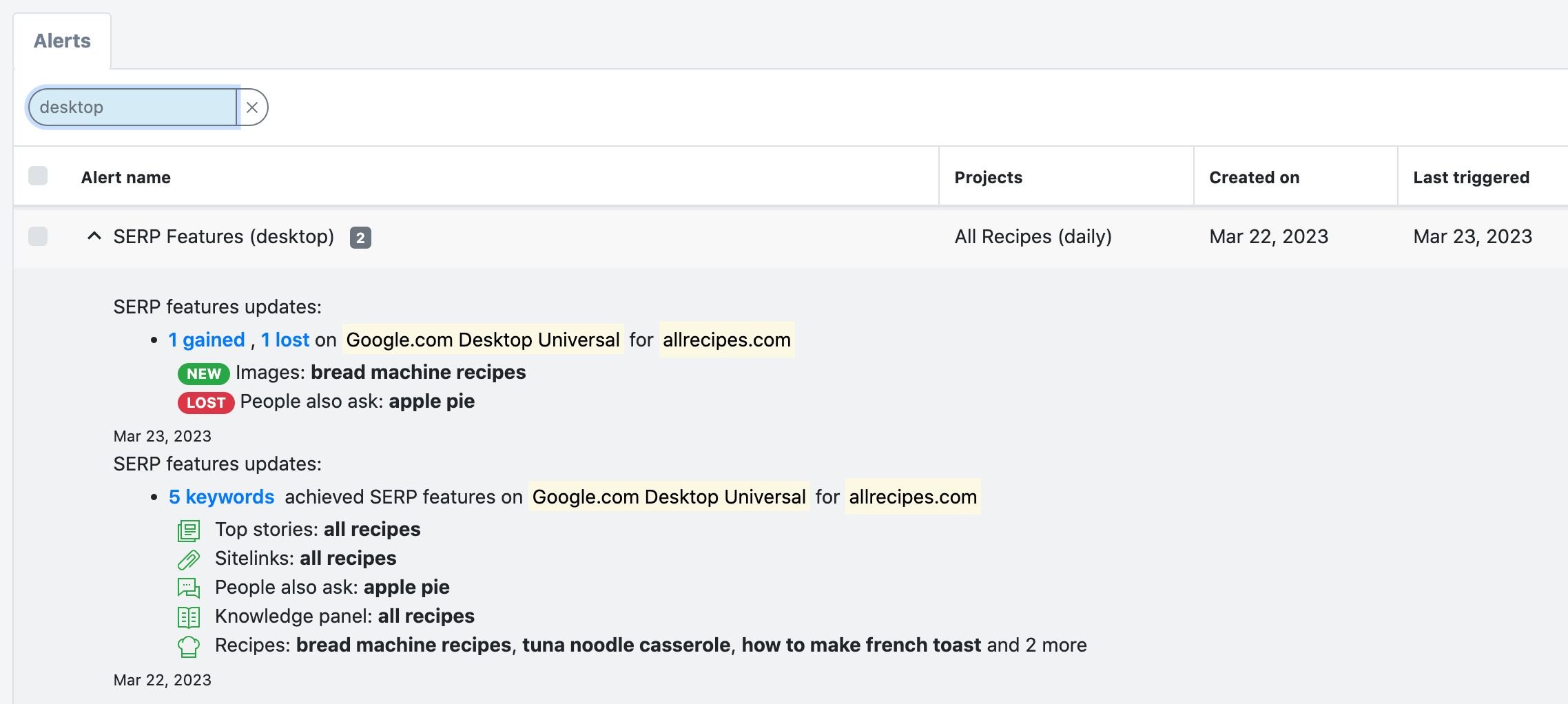
Following the recent update, when the alert is triggered, the list of keywords that have met the SERP Features alert's condition (
Website ranks
or Feature on SERP
) will be grouped by search feature.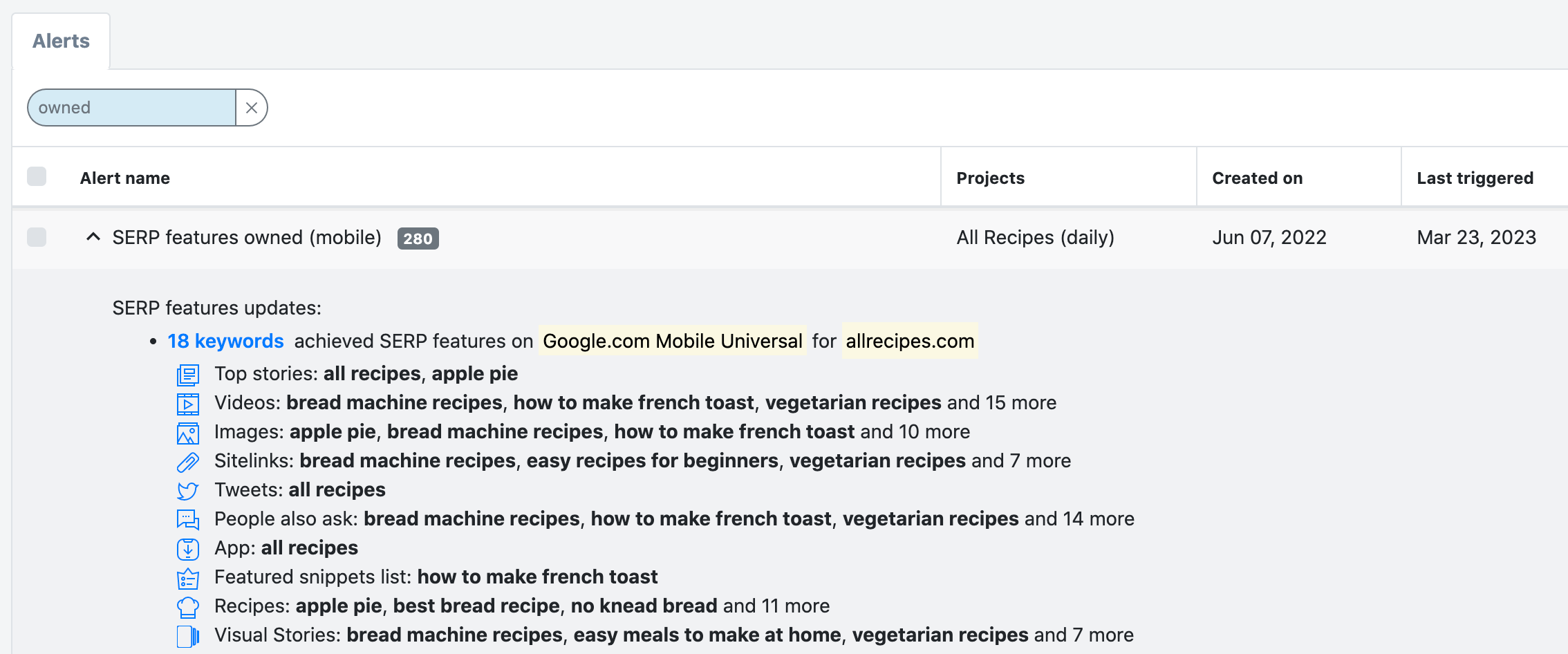
The
alert email body
and the notification received on Slack
have been redesigned to incorporate more insights about the acquired or lost SERP Features.
The
Alert triggers
drop-down menu was also updated with a more compact format and options to edit
or view
the alert's history
.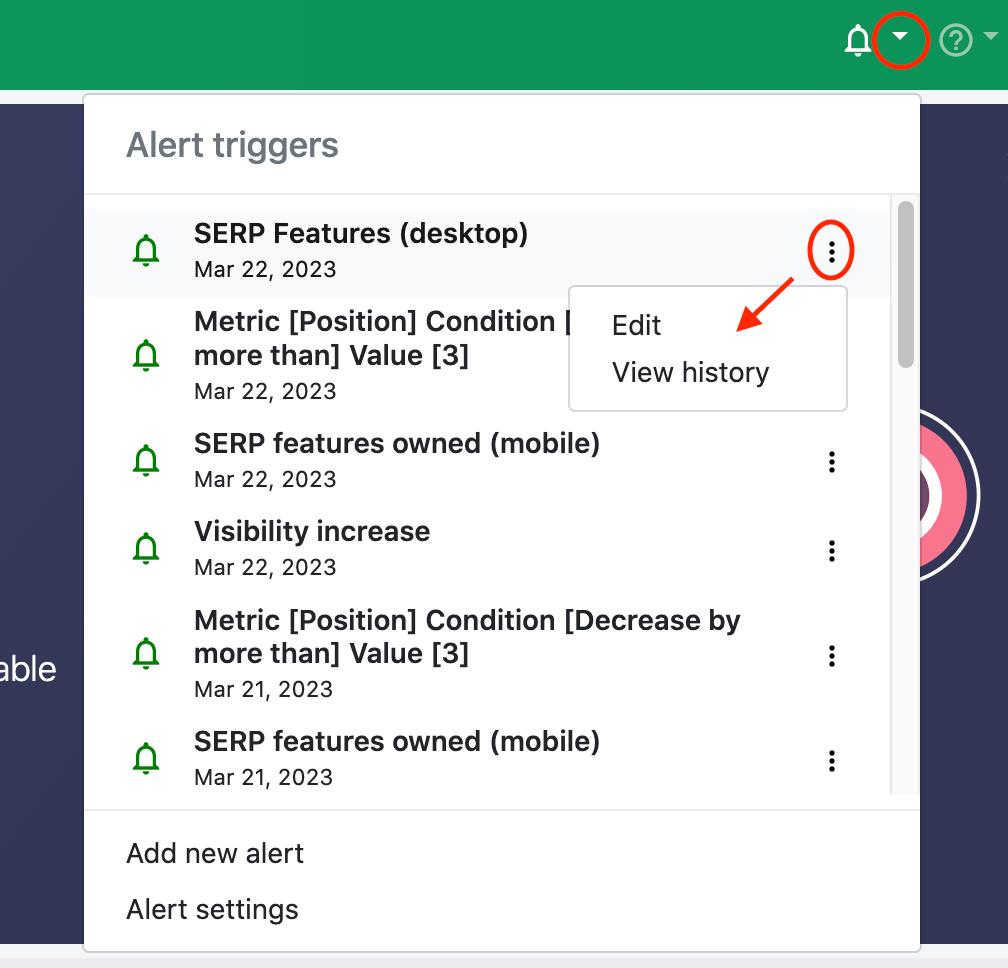
💡
Detailed information on how to use and set alerts to detect changes in SERPs can be found in this article
here.The Developer API and FTP exporting systems have undergone several improvements, as follows:
- Two new parameters - websiteIdandaddSearchIntent- are now available for the export ranking API operation.
The
websiteId
parameter allows you to export the ranking data for a specific website
, whether it is the main website of the project or one of its competitors.The
addSearchIntent
parameter enables you to export the keyword Search Intent. When this parameter is set to true
, two new columns - Search Intent
& Previous Search Intent
are added to the generated export file.- A new API operation - get keywords - was introduced. With this operation, you can retrieve all the keywords and keyword groups for one or multiple projects.

- The keyword Search Intent is now included by default in FTP ranking exports. The ranking files include four new columns: Search Intent, Secondary Search Intent, Previous Search Intent, and Previous Secondary Search Intent.
Feature availability
The Developer API feature is accessible for Agency monthly plans and all yearly subscriptions. On the other hand, the automatic exports to FTP are available for monthly subscriptions starting from the Enterprise level, and for all yearly subscriptions.
Multiple keyword groups can now be applied at the same time to the Comparison > Search engines UI report by using the checkboxes located in front of each group.
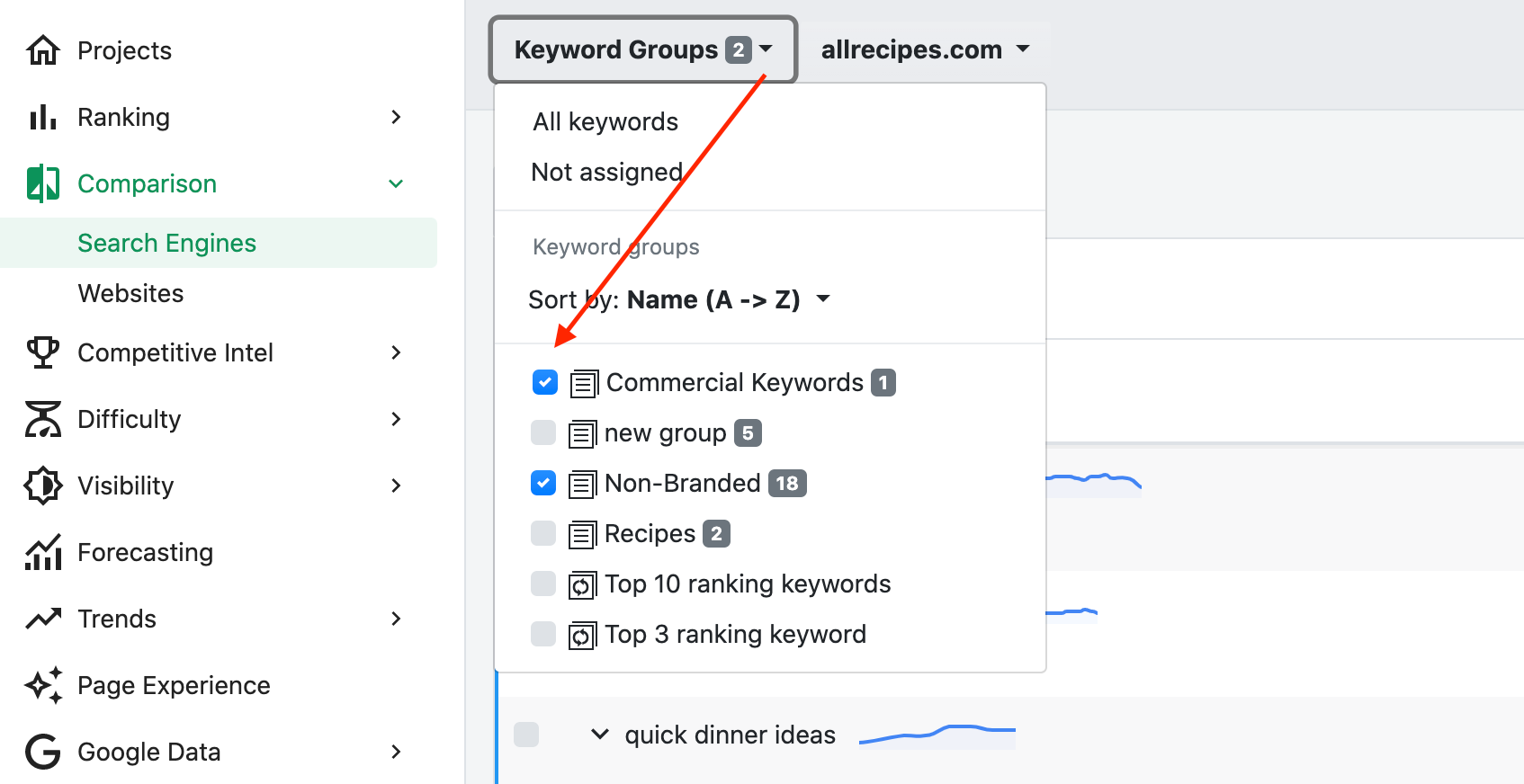
Load More
→